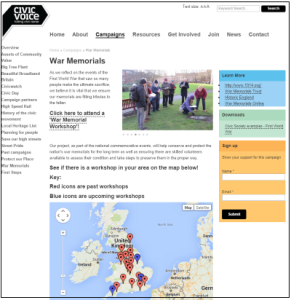 Writing a special guest blog for IHBC members, Ian Harvey, executive director at Civic Voice, which is running a volunteer War Memorials project to help in their care and preservation by volunteers, asks: ‘How will you remember them’?
Writing a special guest blog for IHBC members, Ian Harvey, executive director at Civic Voice, which is running a volunteer War Memorials project to help in their care and preservation by volunteers, asks: ‘How will you remember them’?
Ian Harvey writes:
At this time of year many of us stand at our local war memorial and make the promise ‘to remember them’. In the silence that follows we think about the hundreds of thousands of men and women, especially those from our own communities, who died in the First World War.
These historic monuments, many of them now approaching 100 years old, are like no others because of the poignant role they play in reminding us of the horrific human cost of war and the enormity of the sacrifice made by previous generations. They provide a tangible link to the former members of our communities who were affected by the conflict, both those who fought and died and those who were left behind.
In addition to their primary role as a focus for commemoration, war memorials contribute to the historic character of our villages, towns and cities. More often than not, they were funded by public subscription and decisions were made locally about what form they should take, meaning that many of them are unique in their design. The stories behind how communities decided on their final design, location, the dedicatory inscriptions and the inclusion of individuals’ names, provide a fascinating insight into the social history of the time.
So it is a travesty that there is no definitive record of the estimated 100,000 war memorials thought to exist in the UK. And of even greater concern is the fact that thousands are thought to be at risk, with stonework crumbling, the names of the fallen fading or obscured by dirt, and some, for example plaques, being lost completely during the redevelopment of buildings. The First World War Memorial Programme, a partnership between Civic Voice, Historic England, Imperial War Museums and War Memorials Trust, has been developed to address these issues.
Throughout England a body of volunteer has already embarked on recording the condition of their local war memorials and reporting this to War Memorials Trust through their War Memorials Online website. With this help, the Trust is identifying those memorials that need repair and conservation. During the First World War Centenary an extra £2million of grant funding is available through the Trust for those memorials that are in need of repairs. This will ensure that the country’s war memorials are tributes to the fallen befitting of the sacrifice they made.
Communities are also getting involved in protecting their freestanding war memorials for the future by applying to have them added to the National Heritage List for England. This ‘listed’ status gives them better protection through the planning process as well as highlighting to communities their importance as historic monuments. There are currently 1,800 listed war memorials, a fraction of the number that are actually eligible for protection. With the help of volunteers, Historic England aims to add a further 2,500 to The List by the end of the Centenary.
So next time you are passing your local war memorial, be it a stone cross, a statue, a plaque or a park, keep your promise ‘to remember them’. Take a closer look at its condition and log your findings on War Memorials Online. Your action could kick-start the process of the memorial’s custodian being offered funding for repairs, thus restoring it to pride of place in the community.
For more information contact Civic Voice at info@civicvoice.org.uk, the organisation that is co-ordinating the training and activity of volunteers.
For the War Memorials programme see Civic Voice
For background to the programme see IHBC NewsBlogs and on memorials
Civic Voice website
